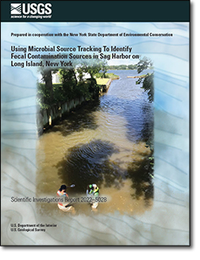Using Microbial Source Tracking To Identify Fecal Contamination Sources in Sag Harbor on Long Island, New York
Links
- Document: Report (1.69 MB pdf) , HTML , XML
- Related Work: Scientific Investigations Report 2021–5033 - Overview and Methodology for a Study To Identify Fecal Contamination Sources Using Microbial Source Tracking in Seven Embayments on Long Island, New York
- Data Release: USGS National Water Information System database - USGS water data for the nation
- Download citation as: RIS | Dublin Core
Abstract
The U.S. Geological Survey worked in cooperation with the New York State Department of Environmental Conservation to assess the potential sources of fecal contamination entering Sag Harbor, an embayment complex on the northern shore of the south fork of Suffolk County, Long Island, New York. Water samples are routinely collected by the New York State Department of Environmental Conservation in the harbor and analyzed for fecal coliform bacteria, an indicator of fecal contamination, to determine the need for closure of shellfish beds for harvest and consumption. Fecal coliform and other bacteria are an indicator of the potential presence of pathogenic (disease-causing) bacteria. However, indicator bacteria alone cannot determine the biological or geographical sources of contamination; therefore, microbial source tracking was implemented to determine various biological sources of contamination. In addition, information such as the location, weather and season, and surrounding land use where a sample was collected help determine the geographical source and conveyance of land-based water to the embayment.
Analysis revealed that the most substantial source of fecal contamination to Sag Harbor was discharge from sites draining ponds and wetlands, particularly during the summer months. Fecal coliform bacteria at sites where ponds and wetlands drain are increased by stormwater runoff, which is another substantial source of fecal contamination. Human markers were detected in all four samples at the Sag Harbor Sewage Treatment Plant Outfall site but were associated with low fecal coliform concentrations, indicating that the sewage treatment plant is not a likely source of fecal contamination to the embayment. The Ligonee Brook Culvert, Paynes Creek near Marjorie Lane, and Otter Pond Culvert sites were identified as locations that contribute fecal contamination to Sag Harbor. These three locations had high fecal coliform bacteria concentrations in the summer, one of which was positive for canine microbial source tracking markers (Ligonee Brook Culvert), and another positive for waterfowl markers (Paynes Creek near Marjorie Lane). The absence of fecal coliform bacteria and human microbial source tracking markers in groundwater samples indicates that water from septic systems does not influence the harbor; however, elevated fecal coliform bacteria concentrations were not often detected. Further, the sandy sediment alongside Sag Harbor is unlikely to contribute fecal coliform bacteria when resuspended in the water column through tidal shifts or boat activity.
Suggested Citation
Tagliaferri, T.N., Fisher, S.C., Kephart, C.M., Cheung, N., Reed, A.P., and Welk, R.J., 2022, Using microbial source tracking to identify fecal contamination sources in Sag Harbor on Long Island, New York: U.S. Geological Survey Scientific Investigations Report 2022–5028, 17 p., https://doi.org/10.3133/sir20225028.
ISSN: 2328-0328 (online)
Study Area
Table of Contents
- Acknowledgments
- Executive Summary
- Introduction
- Site Description
- Approach and Methods
- Results
- Classification of Source Sites
- Summary
- References Cited
- Appendix 1. Sample Collection in Sag Harbor on Long Island, New York
| Publication type | Report |
|---|---|
| Publication Subtype | USGS Numbered Series |
| Title | Using microbial source tracking to identify fecal contamination sources in Sag Harbor on Long Island, New York |
| Series title | Scientific Investigations Report |
| Series number | 2022-5028 |
| DOI | 10.3133/sir20225028 |
| Publication Date | April 05, 2022 |
| Year Published | 2022 |
| Language | English |
| Publisher | U.S. Geological Survey |
| Publisher location | Reston, VA |
| Contributing office(s) | New York Water Science Center |
| Description | Report: vi, 17 p.; Data Release |
| Country | United States |
| State | New York |
| City | Sag Harbor |
| Other Geospatial | Long Island |
| Online Only (Y/N) | Y |
| Additional Online Files (Y/N) | N |


